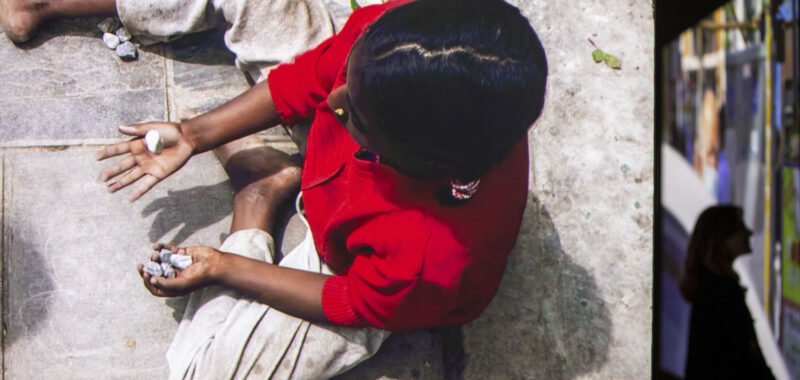LONDON — Shouts ring out, voices chant, hands clap, and children’s laughter bursts from every direction. If you close your eyes in the middle of Francis Alÿs: Ricochets at Barbican Art Gallery, you might think you’re in a multinational playground. Suspended screens glow with videos of children playing games in different locations, from the snowy mountains of Switzerland to the war-torn streets of Iraq to the urban pavement near the Barbican. The noise is almost overwhelming at times. Ear defenders are available to borrow — although keeping these on my toddler became a game in itself (which I ultimately lost).
The exhibition centers on Alÿs’s Children’s Games (1999–present), an ongoing series of films exploring play and collective agency. The films are utterly compelling, demonstrating the ingenuity and collaboration of children, who carve out urgent spaces for fun even amid war, poverty, and urban desolation. In the Danish game Kluddermor, a circle of kids tie themselves up in knots before calling for “mother” (played by another child) to untangle their limbs. In Haram Football, a group of Iraqi boys play football without the ball, as the game had been banned by the Islamic State. My daughter loved Slakken, in which Belgian children cheer on snails daubed with colorful chalk, making for a slow race with a surprisingly tense photo finish.

One of the most absorbing films shows girls in the Democratic Republic of Congo playing Nzango, a mysterious game with an esoteric set of rules. Two teams clap and chant, taking turns copying or somehow telepathically anticipating the leg movements of the opposite team member. Alÿs’s editing further masks the game’s logic, focusing on its extraordinary rhythmical movements and energy. Do these unspoken collaborative actions hold lessons for adult society? Alÿs doesn’t answer this, but he does point to the powerful potential of play to bring people together.
While the ground floor gallery featuring the films is spectacular, the upper floor feels underwhelming. Large, dark rooms make it frustratingly difficult to keep an eye on an exploring child. Some rooms display hand-drawn animations that distill elements of the films: a pair of legs swinging with the aimlessness of childhood, hands gently forming shadow puppets. There are also two “playrooms” that feel stubbornly, even perversely, minimalist. One contains three small round stool seats on castors and a white circle painted onto the ground. In the other, a projector throws a blade of bright, watery light into the opposite corner, where visitors can interact with their shadows.

These dark spaces reject the hyper-colorful, plastic-coated aesthetic of a soft play zone, and push back against the excess of plastic toys in the West. This is laudable, and most of the games featured in the films use no props, or makeshift ones such as rocks, snails, conkers, and sticks. The problem is that the dark, monochrome playrooms just aren’t much fun. My toddler did enjoy picking up and throwing the wheely stools (which seemed like a bad idea), but she wouldn’t go near the intimidating shadow wall. Admittedly, she is very young and only had her unimaginative parents to play with. Perhaps a group of older children would bring these spaces to life with newly invented games, but during my visit only a couple of kids were in attendance.
One work that stood out among the lively films and deserted playrooms was a small spotlit painting of a lanky, awkward boy teetering on the edge of adolescence. He leans against a tree, covering his eyes. Is he despairing or simply counting in a game of hide-and-seek? Perhaps when he opens his eyes, he will find himself alone — a symbol of the increasing isolation that often accompanies the transition to adulthood, as we leave behind the collectivity of childhood play, which, the exhibition suggests, we should endeavor to reclaim.



Francis Alÿs: Ricochets continues at Barbican Art Gallery (Silk Street, London, England) through September 1. The exhibition was curated by Florence Ostende, with Inês Geraldes Cardoso.

